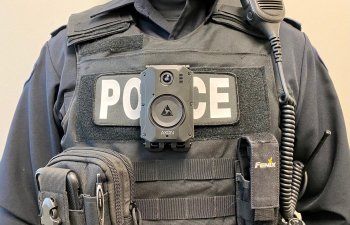Body-worn Cameras

The element of video has evolved rapidly over the past few years, becoming an integral part of our society. It has also affected policing in the many different ways it is utilized; from home security systems and cell phone recordings to in-car cameras, the use of video is common and can be an important investigative tool. It also provides a new level of accountability and transparency. This has been proven with law enforcement agencies across the globe adopting body-worn cameras (BWC).
In March 2022, the Saskatoon Police Service implemented the BWC program, deploying 40 cameras to front-line officers in the Patrol, Traffic, Foot Patrol, Bike and Community Mobilization Units, and Alternative Response Officers. The audio and video recording device will document police and civilian interactions while engaged in enforcement and investigative duties. This includes but is not limited to calls for service, including mental health, traffic stops, and contact interviews. BWC’s are intended to support law enforcement duties and aid in capturing certain incidents. They are not intended for continuous recording. BWC’s are openly displayed to the public and will show an illuminated red LED light notifying the public when the camera is recording.
The goals of equipping front-line officers with BWC’s are to:
- Provide additional evidence for investigations
- Support early case resolution in legal matters and public complaints
- Provide a record of police encounters with the public
- Increase public trust and confidence
- Increase police transparency and accountability
- Provide additional training and leadership tools
Officers are trained to be aware of interactions with the public that may be sensitive in nature, such as when children are present, during a sexual assault or domestic violence investigation. Additionally, a video management team is responsible for the removal/redaction of privileged, sensitive or clearly irrelevant content prior to the disclosure or release of a copy of a BWC recording.
SPS officers must balance the privacy rights of individuals with the anticipated benefits of using BWC’s for law enforcement purposes. The program and policy is will be evaluated on an ongoing basis to ensure its compliance with the Canadian Charter of Rights and Freedoms, the Criminal Code of Canada and provincial legislation. Recording in a private place is dependent on the lawful authority of an officer’s attendance at the location. Some examples include receiving consent from the owner/occupant, in relation to a search warrant or exigent/extenuating circumstances.
“Body-worn cameras can’t replace an officer’s perceptions, but they can be extraordinarily valuable when they confirm the presence of weapons, capture resistance, and verify de-escalation attempts. What’s more, it is expected that the presence of cameras encourages people on both sides of the lens to be the best version of themselves as they interact.”
- Von Kliem – Force Science
FAQ
When will BWC’s be used?
During incidents including but not limited to calls for service, including those related to mental health, traffic stops, and contact interviews. Camera’s will be activated upon arriving at an incident and will continue to record until the incident is completed.
Will officers notify a member of the public when they are being recorded?
Officers are trained to give notice of the camera’s operation as soon as reasonably possible. The timing of this notice may vary depending on the context and safety of the encounter. To signal its activation, the camera will emit three audible sounds, and flash red.
Do I have the right to refuse being recorded?
Officers take reasonable steps to balance the privacy rights of individuals with the benefits of using body-worn cameras for law enforcement purposes. Recording under certain circumstances will depend on the lawful authority of the officer’s presence.
What if I am an innocent or uninvolved bystander and a BWC records me?
If the video is disclosed for court purposes or through a FOIP request, the video management team will be responsible for the removal or redaction of privileged, sensitive, or clearly irrelevant content prior to the disclosure of a BWC recording.
Can members of the public/media access recordings?
Unlike the United States, there are significant privacy implications in Canada governing our ability to release BWC footage to the media and/or public. In the vast majority of incidents, it is expected that recordings will not be released publicly, however, members of the public can access the video by submitting a FOIP request. Members of the public cannot request the data to be deleted; recordings are stored according to the retention policies and if disclosed for court purposes, will be redacted and vetted for any privacy-related concerns or issues.
Can recordings be edited? If so, by whom?
Recordings cannot be edited, altered, or deleted from the camera by a police officer. The video management team has access and permissions to search and view BWC recordings for the purposes of preparing redacted copies for court disclosure purposes and FOIP requests. They are responsible for the removal or redaction of privileged, sensitive or clearly irrelevant content prior to the disclosure or release of a copy of a BWC recording. An unedited version of the recording will be saved and will remain accessible (until retention policies dictate its deletion).
How long will recordings be retained?
Recordings are held for a minimum of two years and then securely deleted. Any further retention of evidence for investigations are guided by The Police Act, 1990.
